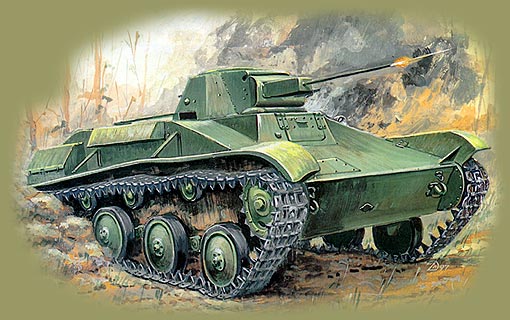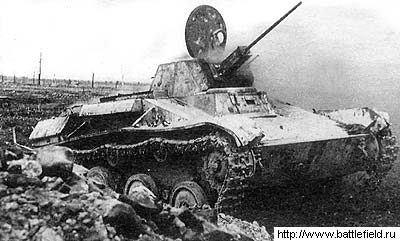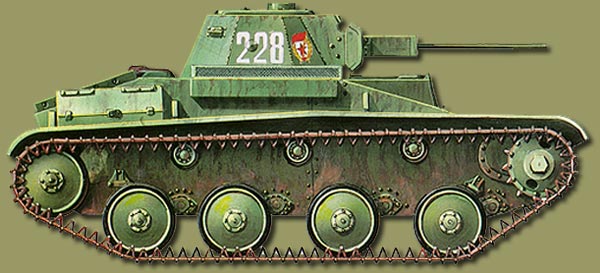| The T-60 Light Tank |
|---|

The first verified battle involving the T-60 light tank occurred at the end of September 1941, while serving in the 10th Tank Brigade they were involved in intense battles near the Poltava region.
Large numbers of this tank fought in the Battle for Moscow (1941-42). Those tanks fought in almost tank brigade and battalion strength. On November 7, 1941, 48 T-60's took part in the Red Square military parade. Just after the parade, the tanks were sent to front. Many of those tanks were built in Moscow factories. Tanks of the Gorkij Factory (GAZ) first appeared on the Eastern Front on December 13, 1941. The role of the T-60 in the Battle for Moscow was very important because the overall Soviet tank production of that time was extremely low as most Soviet industry was being evacuated. Only the STZ and KTZ factories were operational, though KTZ in Leningrad was already encircled by German forces, thus in effect, only STZ remained. However, STZ itself didn't produce tanks, it only assembled tanks from already manufactured parts. Those hulls, turrets, and chassis elements were supplied by other factories which were already being evacuated and were not operational. |
By the beginning of spring of 1942, 60 T-60 tanks were sent to the Leningrad Front to form the 61st Tank Brigade. It is interesting to note that since Leningrad was encircled by the Germans, it was important to hide delivery of those tanks, and therefore tanks were put on coal barges and well-camouflaged with coal. Those barges often delivered coal to Leningrad, and the Germans didn't pay them proper attention and allowed them to pass unharmed, and all the tanks were delivered successfully in this manner. On January 12, 1943 (the first day of the Soviet offensive which broke the Leningrad encirclement), the 61st Tank Brigade together with the 86th and 118th Tank Battalions were engaged in battles as elements of the 67th Army. Tank units of medium and heavy tanks crossed over the ice of the Neva river a day later, after Soviet infantry supported by light tanks and sappers had strengthened the ice for safe tank crossings. Tanks of the 61st Tank Brigade successfully met with units of Volkhovsky Front, and after that operation, the 61st Brigade received the "Guards" status and renamed the 30th Guards Tank Brigade. There were several successful attempts to increase the frontal armor of the T-60. Additional 10 mm armor plates were placed on the glacis of the hull and around the turret. T-60's were used on the Southern Front, especially in the spring of 1942 in the Crimea. These tanks were used in the Kharkov operation as well as during the Stalingrad operation. The Germans called the T-60 the "ineradicable locust." |
 A knocked out T-60. Leningradsky Front. 1943. (RGAKFD) |
T-60 tanks were the core of the 1st Tank Corps (commander - Major-General M. E. Katukov). In the summer of 1942, this corps, as an element of the Bryansk Front, was engaged in defensive battles near Voronezh. The 1st Tank Corps and the 16th Tank Corps were combined as a single unit. After the heavy battles, this unit was in a desperate situation. Katukov relates in his memoirs: |

"The Germans attacked us continuously. They tried to find a weak point in our defense. After several attempts they found it, and German infantry was able to make a breakthrough through our first lines of defense where we didn't have proper artillery coverage. It was a precarious situation, because the Germans continued their attacks to cut off and destroy our forces. |
In September 1942, during the rugged defense at Stalingrad, the 91st Tank Brigade was engaged in action having T-60 tanks in its service. Many of those little "baby" tanks had impressive nicknames like "Grozniy" (Terrible), "Orel" (Eagle), "Smelij" (Brave), etc. The Stalingrad battle and the run on the Leningrad blockade became the apogee for T-60 light tank. From the end of 1942, the usage of these tanks decreased. They served well and completed their tasks but they couldn't withstand modern German tanks and the increasing demands placed upon them. The use and production of the T-60 was on the decline. Soviet tankers didn't love the T-60 because of its weak armament and too light armor. Tankers called them BM-2 which meant "Bratskaya Mogila na dvoikh" (a brother's grave for two). Breaking the encirclement around Leningrad (January 1944) was the last large operation where the T-60s took part. For example, among the 88 tanks of the 1st Tank Brigade there were 21 T-60's, and 18 T-60's were in the 220th Tank Brigade. At the same time, the 124th Tank Regiment (attached to the Volkhov Front) possessed only ten tanks: a pair of T-34's, a pair of T-70's, five T-60's and one T-40 (still alive! unlikely, but true!). After that operation, T-60's were used only as convoy vehicles, in signal units, for reconnaissance, and as artillery tractors for ZIS-2 antitank and ZIS-3 field guns. They were also used as commanders' tanks. In that capacity, T-60's were used until the end of the war. Besides the Red Army, three T-60's served in the Voisko Polskoe (Polish Army) in 1945. Many T-60's were captured by the Germans and Finns. The Germans usually used them as armored tractors, and occasionally they removed their turrets. Some of those tanks were given to Rumania. The Rumanians used them to build a batch of quite successful self-propelled guns "Takam," armed with the ex-Soviet 76.2 mm F-22 (the predecessor for the ZIS-3 Field Gun) installed in a non-rotating compartment open at the top and rear. The hull and the chassis of T-60 satisfied the Rumanians and were left almost unchanged. Moreover, some sources indicate the Rumanians built two other self-propelled guns armed with a 105 mm howitzer. After the war, all surviving T-60's were quickly removed from service. Today, the last "pure" T-60 is displayed in the tank museum in Kubinka. |
| REFERENCES: Development history Modifications of the T-60 Blueprint of the T-60 Specification of Soviet tanks Specifications of Soviet tank guns |
Proof-reader:
Mark Jaremco Sources: "The T-60 tank. Operational manual", Voenizdat 1942; Technical guide of T-60", Voenizdat 1944; "Bronekollektsiya", #4 1997. |